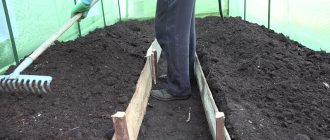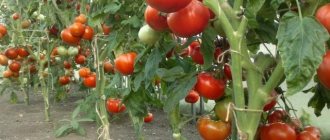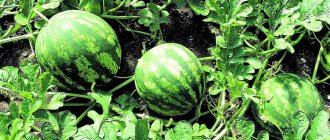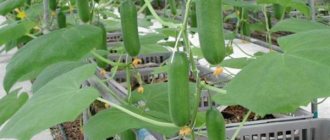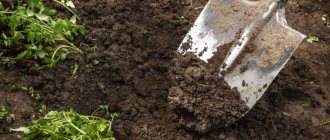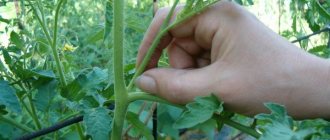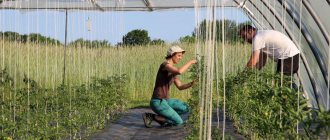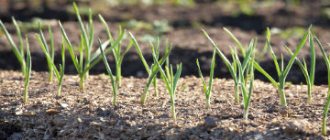DIY soil for a greenhouse
The volume and quality of the crop you will harvest in the fall directly depends on the condition of the soil in the greenhouse.
Moreover, just applying fertilizers, loosening, changing crops is not enough. In order for plants in a greenhouse to bear fruit well, it is necessary to select the optimal soil composition for them and properly disinfect it. The preparation of soil for the greenhouse for winter is of great importance. Below we will look at all these questions. It also provides guidance on partially replacing the soil in your garden beds.
General recommendations for soil care in a greenhouse
It is worth considering that it is important not only to make high-quality soil for the greenhouse. It also needs proper care, which will increase productivity. Recommendations:
- It is necessary to carry out regular watering, which will protect the soil from drying out.
- Mineral fertilizers are also applied, which enrich the soil with nutrients.
- A favorable microclimate should be created inside the greenhouse.
This is due to excessive humidity inside the structure. The earth not only turns white:
- In some cases it turns green.
- Both types of fungal diseases are not only dangerous for plants, but also for humans.
- Getting rid of this type of mold is quite difficult.
It is best not to overdo it with irrigation and regularly ventilate the greenhouse so that it always maintains a constant temperature.
Soil in a greenhouse: selection of composition, basic manipulations, preparation for winter
The more attentively you pay attention to the condition of the soil in a polycarbonate greenhouse, the more hassle-free your plant care will be, and the harvest will delight you with its volume.
What soil is best for a greenhouse? Choosing the optimal composition
It may seem that the simplest thing is to buy ready-made soil for a greenhouse in bags, optimized specifically for the crops that you are going to grow. On the one hand, this is true, on the other hand, such “pleasure” will be very expensive. Therefore, the best option is to prepare the soil yourself. For mature plants that will bear fruit, medium-density soil is better suited. The approximate composition of soil for a polycarbonate greenhouse will be:
- Sod land - 2 parts.
- Humus - 2 parts.
- Peat – 1 part.
- River sand – 1 part.
This option is suitable for most crops grown indoors.
What soil is best to use for a greenhouse: turf soil is an integral part of many compositions
To grow seedlings, you need light soil, rich in minerals, organic matter, with good moisture and gas permeability. Therefore, peat-based mixtures will be especially good.
Peat soil for greenhouses, composition for seedlings:
- Peat – 3 parts.
- Forest foliage – 1 part.
- Humus - 1 part.
- Sod land - 1 part.
Please note: you should not add manure, even out of a desire to make the soil more nutritious. Because of it, the acidity of the soil will increase, making it unsuitable for growing seedlings.
Peat mixtures are used for seedlings
Making soil for a greenhouse with your own hands
All components of the soil for seedlings should be prepared in the fall. Any convenient containers or strong plastic bags are suitable for storage. The shelter where the ingredients for the soil will be stored should be cool, but without the temperature dropping below 0 degrees. We mix the composition and add the necessary fertilizers immediately before sowing the seeds.
For adult plants, the technology will be different. The only common point is that work also begins in the fall. We bring all the components into a pre-prepared, disinfected greenhouse and lay them in layers. If necessary, sprinkle with fertilizers. Next, we dig everything up and leave it like that for the winter. In the spring, we dig up the soil for the greenhouse with our own hands again, spreading it in a layer of 25-30 cm. We finally form the beds.
Leveling soil components
Soil disinfection
Over the summer, a large number of harmful microorganisms and insects manage to multiply in the soil of the greenhouse. If we leave everything as it is, then by the next season we will get a “time bomb”, the blow of which will be taken by the planted plants. As a result, the new harvest will suffer qualitatively and quantitatively. Disinfecting soil treatment in the greenhouse in the fall will help to avoid diseases.
- Fumigation. The simplest option. We simply place a sulfur bomb in the middle of the greenhouse, set it on fire and leave, closing the door tightly. After two days, we ventilate the room well, and then preserve it for the winter.
- Using hot steam or boiling water. The soil is treated with a steam generator or poured with boiling water. This method is suitable only for small greenhouses.
- Using a solution of copper sulfate - 1 tbsp. spoon for 10 l. water.
- Sprinkling the soil with dry bleach. The procedure can only be carried out in the fall.
- Treatment with ready-made antiseptics. The dosage and conditions for using drugs are always in the instructions for them.
How to prepare soil for a greenhouse: disinfection with a sulfur bomb
Preparing the soil for the earth
The first stage of soil preparation in a greenhouse in the fall is disinfection, which was discussed above. Next is the enrichment of the depleted fertile soil layer:
- We throw in sawdust, compost, and dig it all up.
- Thickly cover the surface of the earth with chalk.
- We spread a layer of dry humus, approximately 15 kg per 1 m2.
Soil: ready-made or homemade?
Not only beginners, but also experienced gardeners often face the question: “So, should I make soil for tomatoes myself, or should I buy a ready-made mixture?” If you decide to purchase soil, then be sure to treat it with the biological solution “Fitolavin”, taking 2 ml per liter of water. You cannot be completely sure that the purchased land did not come into contact with anything during harvesting.
We invite you to familiarize yourself with the Poppy flower: care and planting, how garden varieties bloom, how the plant reproduces
Good soil for greenhouse vegetables is obtained from a mixture of turf and humus soils, taken in equal proportions and loosened with sawdust. Additionally, you can purchase “Tomato and Pepper” soil, in which all the necessary substances and elements are more accurately calculated. It is sold in plastic bags of 4 kg, and you need to add 3 kg per 1 m2, separately into each hole. Here we are talking about the traditional version. Also use the popular coconut substrate, which is especially good for seedlings.
But note that the most dangerous moisture for greenhouse tomatoes is soil moisture. Wet, compacted soil quickly promotes the development of all kinds of diseases. Check the soil you have prepared for moisture: make a lump, and if it crumbles easily when touched, then everything is in order.
Many craftsmen use almost nothing but sand as a substrate so that it instantly dries and is saturated with oxygen. But then the process of growing tomatoes is already different from the usual one.
Remember one very important rule: the soil made for the greenhouse should smell like earth! Moreover, it smells pleasant, but any foreign smell indicates that the substrate lacks organic matter or contains other undeclared elements.
Features of soil for greenhouses
If, when growing garden plants in open ground, in order to obtain stable yields, the soil must be regularly fertilized and crop rotation observed, then in a greenhouse it must be periodically replaced. The fact is that a small amount of land is very quickly depleted by plants, and if it is not changed, you will not expect good yields in the next planting season.
In order not to change the soil too often, you need to take care of its optimal composition from the beginning. That is, for a greenhouse you will need to use a slightly different soil than that located in open beds. A special greenhouse soil mixture can be purchased ready-made or mixed with your own hands. If prepared correctly, replace the top 5–6 cm layer annually. If the greenhouse is of a rack type, then the soil is completely replaced once every 2 years.
Types of greenhouse soils
Conventionally, soil for greenhouses is divided into 3 main types:
- Peat . This species can be harvested in swamps. It is well enriched with humus. Pure peat is not used. It is mixed with manure and lime. It is included as an additional, but not the main component. Allows you to maintain the required temperature and retain moisture. Approximately 20–25 kg/m² is added to light soils, and 15 kg/m² to heavy soils.
- Compost . This is what has accumulated in the compost pit: food remains, household waste in a rotted form. Compost is characterized by a high content of organic matter.
- Leafy or woody . Harvested in forests and meadows. Included in the soil mixture in an amount of 30%.
Based on their mechanical composition, the following types are distinguished:
The choice of soil is carried out according to the preferences of the crop that is grown in the greenhouse. For example, for cucumbers, compost soil containing humus, peat and turf soil is selected. For tomatoes - turf.
How to fertilize the soil?
When preparing a greenhouse for planting, soil fertilization plays an important role. A gardener can use either organic fertilizers or ready-made mineral complexes , which contain the entire necessary set of nutrients.
Organic fertilizers for greenhouses
River silt, peat, tree bark, reeds, humus, bird droppings, and algae are used as organic fertilizers The undoubted advantage of such fertilizers is their naturalness.
They saturate the soil with nutrients and improve the functioning of beneficial microorganisms. In addition, only with their help can you easily warm up the soil, which will allow you to plant the first plants much earlier.
The most useful fertilizer for the soil is manure. It has all the nutrients. Soil fertilized with manure becomes loose, light, and airy.
Manure can be introduced into the ground both in autumn and spring. In the fall, you can use fresh material: before spring it will rot and turn into an excellent fertilizer for future plants. But in the spring it is better to use rotted manure: caustic substances contained in fresh material can damage the root system of seedlings.
Mineral fertilizers
Fertilizing the soil with mineral fertilizers contributes to a significant increase in plant productivity. But they should be used with caution: the wrong dosage can ruin the entire fertile layer of soil. A gardener who decides to fertilize greenhouse soil with mineral fertilizers should be sure to read the instructions.
There are fertilizers that supply the soil with a specific element: phosphorus, nitrogen or potassium. They are called simple. complex fertilizers , which provide seedlings with the entire set of nutrients at once, are more popular
Every gardener knows how important it is to prepare the soil in the greenhouse for planting. After all, only if all recommendations are carefully followed can you get a good harvest and provide your family with environmentally friendly products for the whole winter.
Optimal soil composition for a greenhouse
There are several requirements for greenhouse soil.
She must be:
- rich in nutrients;
- loose consistency;
- with good moisture and air permeability qualities;
- with a large amount of humus in the composition;
- with the pH level required for the crop being grown. Most plants prefer neutral acidity.
It is necessary that solid, gaseous and liquid components be contained in equal quantities.
Good greenhouse soil must contain components that serve as fertilizer (contain a large amount of nutrients) and raising agents.
The optimal composition of the soil should consist of the following components:
- lowland peat;
- humus;
- turf soil;
- meadow soil;
- sand;
- leaf soil (rotted compost).
In heavy soils, turf predominates (3 parts). They also include humus (1 part) and sand (1 part). Medium soils are filled with turf (2 parts), humus (2 parts), peat (1 part), sand (1 part). The lungs contain peat (3 parts), deciduous soil (1 part), humus (1 part), heather (1 part).
Soil composition
When preparing a soil mixture, it is important to determine the chemical composition and acidity level of the soil in order to know which components and in what proportions need to be mixed to achieve the ideal composition.
Based on their composition, soil mixtures for greenhouses can be divided into:
- light, which consists of peat, compost and humus in a ratio of 3:1:1, or peat, forest leaves, humus and turf soil in a ratio of 3:1:1:1;
- medium, consisting of turf soil, humus, peat and sand in a ratio of 2:2:1:1;
- heavy ones, which consist of turf soil, sand and compost in a ratio of 3:1:1.
Light soils are suitable for seedlings, medium soils are suitable for mature plants of most greenhouse crops.
Preparing soil for greenhouses with your own hands
Ready-made soil mixtures are sold, compiled in accordance with the preferences of a particular plant. However, you should understand: purchasing such a soil mixture is not always advisable. Growing vegetable crops can be very expensive, so many greenhouse owners resort to making their own soil to save money. It should be noted that when properly prepared, such mixtures are in no way inferior in quality to store-bought ones. It is important to choose the appropriate composition, pickle and adjust the acidity level. Each greenhouse owner can choose the composition that is most accessible to him and which he can easily prepare.
Soil disinfection
Disinfection of the land must be done every time after harvesting. Pickling allows you to get rid of accumulated harmful substances, pathogens and harmful insects.
Disinfection is carried out in several ways:
- Using heat treatment.
- By freezing.
- Using chemicals.
- Introduction of biological drugs.
- Complete or partial change of soil.
Heat treatment
Heat treatment involves watering the soil with boiling water or steaming it over steam. The soil must be kept over boiling water in the boiler for at least 25 minutes. However, it is worth understanding that along with harmful microorganisms, beneficial bacteria also die during steaming. There are special steam engines that are also used to disinfect soil. After watering with boiling water, the soil must be covered with film to allow it to steam.
Another simple method of heat treatment is to heat the soil collected in bags under the scorching sun for 1–2 weeks. In addition to exposure to high temperatures, disinfection is also carried out using low temperatures. You need to freeze the ground 2 times. The soil is poured into bags and taken out into the cold. After which they bring it into a warm room. Then frozen at –15°C. And again return to warm temperature.
Treatment with chemicals
There are many chemicals that are used to treat greenhouse soil.
- Formalin (40%) . It is used in the spring, a month before planting begins. During processing, the temperature in the greenhouse building should be maintained at +10...+12°C. At higher temperatures, formaldehyde will evaporate. After the treatment is completed, the temperature in the greenhouse should be raised to +25°C. This will allow formaldehyde vapor to evaporate. After 24 hours you need to ventilate.
- Copper sulfate (2–3%) . Treatment with this substance is carried out in the fall. It is used both for the soil and for disinfecting the entire greenhouse. It fights well against late blight, powdery mildew, spider mites, rot, and scab. To be paid once every 5 years.
- Fungicides . Any systemic fungicides are suitable, for example, Aktara, Fundazol. It is better to use those that can be used in the form of steam or gas. Such treatments are carried out in the fall. In spring you can only use Chloropicrin. The temperature should not be higher than +17°C.
- Bleaching powder. Recommended doses of powder application are 200–300 mg/m². Processing is carried out in the fall, after harvesting.
- Sulfur . It is used in the form of a checker, which is set on fire and fumigates the soil with smoke. Fumigation is carried out in the fall. After burning, the greenhouse is ventilated. Sulfur bombs are not used in greenhouses that have a metal body, since smoke leads to corrosion.
Biological method
The biological method involves crop rotation, i.e. changing closely related crops once every 1–2 years. Thanks to this, it is possible to prevent the spread of pathogens and harmful insects.
This method also includes treatments with biofungicides “Baikal”, “Baktofit”, “Trichodermin”, “Gaupsin”, “Fitosporin” and similar in action. These products increase the nutrient content in the soil and at the same time reduce the content of pathogenic flora. This is one of the best disinfection methods, since it allows you to kill all bad flora and preserve good flora, bind heavy metals, and preserve nitrogen levels. After such treatments, there is no need to wait time; plants or seedlings can be planted almost immediately.
However, the main and most common cleaning method is complete or partial replacement of the soil layer.
Adjusting acidity
As we have already mentioned, most plants prefer to grow in soil with a neutral acidity level - 6-7 pH, some require low values, others like slightly acidic soils, so when preparing greenhouse soil, you should definitely control the pH level. This is done using litmus paper and special analyzers.
If the acidity is high, then it can be lowered by adding lime, dolomite flour, or wood ash. These substances are scattered over the soil and dug well.
They acidify the soil by adding manure, compost and peat.
Neutralization of soil in a greenhouse or its replacement
When the revision of the greenhouse structure is completed and all identified deficiencies have been eliminated, the next step on the path to obtaining a rich harvest is begun - cultivating the land before planting.
First of all, it is necessary to protect future seedlings from the influence of microorganisms that harmed plants in past seasons. To do this, it is advisable to completely remove the top layer of soil, which contains most of the harmful fungi and bacteria that can destroy the crop.
Before planting, it is important to disinfect not only the soil, but also the room
If this is impossible to do, don’t worry. High-quality preparation of the greenhouse for planting is also possible when it is treated with disinfectants. It should be done several weeks before planting the first vegetation. Moreover, the amount of time before planting seedlings in a greenhouse is, first of all, determined by the characteristics of the use of a disinfectant.
We invite you to familiarize yourself with what can be made from wood cuts
There are several methods for disinfecting soil in greenhouses:
- thermal;
- biological;
- chemical.
Thermal methods for improving the health of greenhouse soil include freezing and steaming. During the first of them, in winter or early spring, the snow cover is removed and the ground is allowed to freeze to sub-zero temperatures. Naturally, the lower the thermometer reading drops, the more likely it is to destroy microorganisms that can destroy future plants.
Freezing the soil allows you to get rid of many pests
The second consists of watering with hot water followed by covering with dense waterproof material. Under the influence of critical temperatures, most parasites and small pests die and, accordingly, can no longer cause harm to the future harvest. This type of spring soil preparation in a greenhouse is the least toxic and cost-intensive.
Steaming not only destroys pests, but also speeds up the harvest.
Chemical methods for disinfecting greenhouse soil are the most popular. Among the main reasons for their widespread use:
- wide spectrum of action against various parasites;
- the possibility of “spot use” only in relation to a specific pest;
- availability of purchase and ease of use of the substance.
There are two types of chemicals: for liquid or gas disinfection of soil.
Among the disinfectants for soil preparation in a greenhouse, the use of which is carried out in a liquid state, the following can be noted:
- copper sulfate;
- carbation;
- phytosporin;
- viracide;
- formalin and others.
Chemicals effectively disinfect the soil in the greenhouse
All of the above drugs are soluble in water (the proportions are indicated on the packaging) and can be applied to a wide range of pests of greenhouse crops. As for specific disinfection preparations, the following have proven themselves to be quite good:
- Bayleton – a remedy against gray rot;
- Fitoverm - a drug against spider mites, aphids and caterpillars;
- acrobat is an effective cure for late blight and downy mildew.
Disinfection with sulfur destroys pests even in hard-to-reach places
The effectiveness of chemical methods for disinfecting greenhouse soil is indisputable. But their use still does not make it possible to obtain environmentally friendly vegetables. Therefore, it is best to use such methods not in spring, but in autumn, immediately after harvesting. Accordingly, the spring volume of work associated with chemical disinfection of the soil in a greenhouse largely depends on how intensively the greenhouse was prepared for winter.
Less effective than chemical ones, but most acceptable in the context of obtaining environmentally friendly products, are biological methods of soil treatment. Their essence is to introduce living organisms into the soil (with manure or compost) that are capable of destroying greenhouse pests on their own. In addition, you cannot do without:
- soil replacement;
- use of sewing shifts;
- growing green manure.
The results of using biological methods for disinfecting greenhouse soil are excellent, but there are several disadvantages:
- they are not always applicable for a greenhouse;
- their duration of action is calculated from 4-5 years of constant use, and a beginner in greenhouse business cannot use them;
- During the compost process, constant digging is necessary to protect yourself from weeds.
To get the maximum effect from biological soil improvement, it is important to remember three factors:
- The opinion that pests of greenhouse plants completely die under the influence of low temperatures is absolutely unreliable.
- To achieve the desired effect, disinfection as part of preparing the greenhouse for planting must be carried out in conjunction with disinfection of the entire greenhouse structure.
- Fumigation with sulfur is highly undesirable in greenhouses with a metal frame: the gas released significantly accelerates the process of rust.
Steam treatment of the greenhouse and surrounding area
Soil disinfection in a greenhouse is carried out due to two factors:
- The soil has not been used for planting for quite some time.
- If you need to grow other crops on existing soil.
How to disinfect the soil in a greenhouse? This question worries almost everyone. Here you need to follow all the rules and regulations so that clean soil contributes to the normal growth of plants in it. Let’s take a closer look:
- If you do not change the soil in the greenhouse, then every year it will become less and less mineral, and it will become saturated with insects that can corrode the root system from the inside.
- At the same time, the yield will be less and less.
- It is better to bring soil into the greenhouse not from the garden.
- It contains a large number of harmful microorganisms.
To disinfect the soil you will need:
- You can use copper sulfate. Initially, a solution is prepared. To do this you will need a standard bucket of water (10 l) and 1 tbsp. copper sulfate. This solution is used to water the soil after harvesting in the greenhouse.
- There is a special steam treatment of the soil. Under the influence of high temperature, many harmful particles die. To do this, pour boiling water over the soil and cover it with film. At the moment, this method of cleansing is considered the most economical and non-toxic.
- Formalin is also widely used. It is a toxic substance. It is used in its finished form. Grooves are made in the soil and it is poured into them. The grooves are buried, and the soil is not disturbed for 14 days. Then you need to ventilate the structure (at least 2 weeks). After this, the soil is dug well.
- Gardeners use sulfur bomb well. It is installed in the structure and set on fire for an hour. Within 10-14 days after this, the greenhouse is ventilated.
- Bleach can also rid a greenhouse of pests. It is sprinkled on the soil, as it comes in dry form.
To do this you will need:
- Wash windows and doors well.
- Dilute potassium permanganate and wipe all surfaces with its solution.
Recommendations:
- If there is no desire to disinfect the soil, then the soil in the greenhouse is replaced.
- To do this, the soil is completely pulled out.
- New soil is placed in its place.
How to make heating for the soil
You can plant plants in the greenhouse in early spring. However, the soil is not always well heated for these purposes. It takes a lot of time to warm up. If you plan to plant early, then you don’t have to wait for the soil to warm up naturally from the sun’s rays, but warm it up yourself.
There are several ways to heat greenhouse soil:
- Artificial . Involves the installation of special heaters connected to generators. Such equipment is easy to install with your own hands. It is effective in warming the soil, but at the same time significantly reduces air humidity. In addition, it requires a large amount of electricity to operate.
- "Air bag" . It is done by laying out the soil in layers with layers of hard materials - bricks, stones, foam blocks. This layer prevents the penetration of cold from the lower frozen layers of the soil. When making an “air cushion,” the top layer is removed, then a solid layer is placed, which is covered with fertile soil.
- Expanded polystyrene . When insulating in this way, the soil mixture is also laid out in layers. In cross-section it looks like this (from bottom to top): soil - polystyrene - heating cable - sand - fertile soil. This method allows you to maintain a stable temperature in both the soil and fertile layers and retain moisture in the upper layer. Its advantages are that by installing polystyrene foam, you can forget about the problem of warming up the soil for a long time.
Possible problems when using natural soil
If it is not possible to purchase greenhouse soil or prepare it yourself, then you can use soil from the garden. It needs to be taken to a pre-designated place, where it is disinfected, the acidity level is adjusted and saturated with fertilizers.
But when using such soil, some problems may arise:
- The soil may contain herbicides. This will lead to the fact that the greenhouse crop will not be environmentally friendly.
- Accumulation and achievement of dangerous concentrations of constituent mineral substances. This will also negatively affect the quality and safety of the crop. For example, with annual fertilizing with potassium chloride or potassium salt, a large amount of chlorine will accumulate in the soil. Sulfate fertilizing leads to the accumulation of sulfur.
- Using "tired soil" Such land will very quickly be depleted in the greenhouse, which will lead to low or no yields.
So, in order to obtain stable and good yields of greenhouse vegetables, berries and seedlings, the soil in the greenhouse must be periodically replaced and prepared in a special way in the fall and spring. You can purchase it ready-made, make it yourself from various components, or use natural soil extracted from garden beds.
How to make compost soil at home?
Composting allows you to turn various natural waste into nutrient material for the soil, which is a good substitute for manure, without financial costs. Compost is prepared in a hole about 100 cm deep. The height of the pile should be no more than 200 cm, the width can be any.
Compost materials can include weeds, grass, leaves, straw, hay, kitchen scraps and more. An essential component of compost is soil and manure, since along with them beneficial microorganisms that carry out the decomposition process are added to the heap. The optimal option is when the compost heap contains 70% organic matter, 20% manure and 10% soil. To reduce acidity, it is recommended to add lime to the compost composition.
Compost should always be kept moist. To do this, it is recommended to periodically water it with manure mixture. To ensure uniform decomposition of the heap, its contents will need to be loosened and turned over with a pitchfork 3-4 times. The compost mass can be used for its intended purpose when most of the heap has decomposed. This may take approximately 10-12 months.
Timely care of the soil in the greenhouse and its periodic replacement will always ensure high yields. Try to use only high-quality and properly selected soil, otherwise all your work will go down the drain.
Selection of soil base
If a new greenhouse is being built, it is not recommended to use soil from the garden, since various kinds of parasites can live there.
Which soil is best for a greenhouse:
- Pay attention first to the soil. This is a universal direction intended for growing plants or vegetables.
- Soil producers take into account all climatic conditions, which affects further productivity.
Note. There is a lot of money spent on soil every year, so it is best to take some action to conserve the land.
How to prepare the soil correctly
The traditional stage of preparing the soil for tomatoes.
Soil preparation in a greenhouse begins with digging and fertilizing. To get a consistently excellent harvest, you need to ensure that the soil temperature is at a stable level.
The photo shows all stages of work:
We water with warm water.
We prepare the soil for the greenhouse with our own hands:
- First you will need a base in the form of leaves; it is laid under the ground.
- Then add the mixture for humus (ordinary grass will do here).
- Thus, the first stage of preparing the soil for the greenhouse is ready.
- Initial actions helped us saturate the soil with various microorganisms.
- Next we lay down grass and tree leaves (a source of nitrogen).
- After which the entire mixture is treated with warm water.
Advice. Substances of organic origin, according to the rules of agronomy, decompose rapidly. To achieve this goal, we add microbial medicine to the water.
When planting plants, make sure that the thickness of the bed is 100 mm.
Soil and its disinfection
Treatment with copper sulfate.
After the soil in the greenhouse is ready, we proceed to its disinfection. This is necessary if it is necessary to plant another crop. The most common, but expensive method is to replace the soil in the greenhouse.
But you can choose less expensive methods:
Boiling water is poured into the soil and covered with a special film. After three hours, all parasites die.
Advice. After the last procedure, the soil is left for several weeks. Then you need to thoroughly ventilate the room and dig up the ground.
Next stage: soil heating
Methods of heating the soil.
Heating the soil in a greenhouse is the most important point in the arrangement. The temperature regime is maintained by plates that are installed under the soil. This method has a beneficial effect on the development of the root system.
The plates are controlled in several ways:
- A program is programmed for a specific temperature regime.
- From the remote control.
Note. The power of this device is small, so electricity costs will be minimal.
Thus, an excellent microclimate is created for plants, and the equipment itself does not harm the crops.
Certain rules for soil care
How to prepare soil in a greenhouse: care
If favorable conditions are created in the greenhouse, this is the key to an excellent harvest. To get a guaranteed harvest, in addition to preparing the greenhouse soil, you must also follow the rules for caring for the greenhouse:
- To prevent the soil from drying out, the soil must be watered frequently.
- It is important to fertilize the soil base with minerals.
- The soil in the greenhouse must be provided with an excellent microclimate to avoid high levels of humidity, and then the appearance of mold.
- Ensure that there is stable heating of the soil in greenhouses.
- Ventilation of the room is mandatory in order to maintain temperature.
Having studied what kind of soil is needed in a greenhouse, we will consider some of the procedures that must be followed to prepare the greenhouse for the season.
Soil selection basics
Current problems when using natural soil
Active use of beds leads to their depletion.
Selecting soil for closed ground is a rather difficult task.
This is due to the fact that a small volume of soil mass leads to its rapid depletion:
- Firstly, at the end of the harvest, we remove all plant debris, which means that the organic matter necessary to restore fertility does not get into the soil.
- Secondly, the beds are exploited more actively, since the density of plantings in the greenhouse is much higher than in the open air.
- Also, do not forget about abundant fertilizing: after several years, residues of ballast substances included in fertilizers accumulate on the beds.
All this leads to the fact that many greenhouse owners prefer to completely replace the soil once a year.
However, we are faced with the following questions:
- Where to get tons of soil every year?
- Where should I export the waste?
- How to organize the replacement process?
In order not to solve such problems, it is worth initially taking care of preserving fertility and maintaining the physicochemical characteristics of greenhouse soil.
Storage of soil requires a separate space
Basic requirements for soil in a greenhouse
Let's formulate the basic requirements for soil in a greenhouse:
- The soil should be fertile and loose.
- It must contain a sufficient amount of humus (the main component of soil organic matter responsible for fertility).
- The requirements also include the optimal acidity of the substrate (Ph indicator), which must correspond to the crop being grown.
READ ALSO: Onions in a greenhouse - features of growing greens all year round
Maintaining all these indicators at the proper level is not easy. This is why it is so important to prepare the beds with your own hands for the next planting season.
Natural technologies for restoring fertility
Preparing soil for a greenhouse most often includes enriching it with micronutrients. Today there is no unified scheme for such treatment, since the list of substances introduced depends on what crop we are growing and on what treatment the beds were subjected to in the current year.
Photo of beds covered with sawdust
The modern market offers us a wide range of mineral and organic fertilizers. However, as practice shows, in a home greenhouse you can get by exclusively with natural fertilizing.
It may contain the following substances:
- Seaweed meal (contains trace elements and lime).
- Meat or bone meal (phosphorus, nitrate, potassium).
- Lime flour.
- Wood waste (sawdust shavings, leaves)
- Down or feather (contains potassium nitrate)
Naturally, we should not forget about the “classic” fertility restorers - manure, chicken droppings and compost.
Note! In addition to their organic nature, the advantages of such natural fertilizers include their extremely low price.
Soil preparation in a greenhouse most often involves layer-by-layer laying:
- Disinfected soil mixture with added organic matter.
- Humus aged 3-4 years (without hay and straw).
- A layer of freshly cut grass (before flowering, so that weeds do not sprout).
READ ALSO: Planting radishes in a greenhouse - features of preparing seeds and growing root crops
This instruction must be followed immediately after completion of disinfection activities, i.e. in the fall after harvest. This way we can restore the fertility of the beds, and in the spring we will plant seedlings on productive soil.
Some tips from summer residents on soil preparation
Soil in the greenhouse, preparing for the season.
Let's look at some tips from summer residents on preparing the soil in early spring.
We disinfect
How the procedure works:
- We take some drug, for example, Inta-vir.
- For 10 liters we dilute two tablets of Oxycom and one tablet of the drug “Inta-vir”.
- The resulting solution is enough for 20 square meters.
How to fertilize the soil in a greenhouse before planting. How to fertilize the soil in a greenhouse
At the beginning of the season, the soil in the greenhouse is fertilized with phosphorus and potassium. These elements are vital for plants. They increase immunity, strengthen the root system, and promote rapid ripening of the crop. It is better not to add nitrogen during soil preparation. Otherwise, huge plants will grow, but there will be few fruits.
The most accessible source of potassium and calcium is ash. Gardeners usually have a lot of it left after burning branches, weeds and leaves. Completely free, but very effective fertilizer.
The source of phosphorus is superphosphate, bone meal. It is best to dig in superphosphate in the fall, since it takes quite a long time to break down to a state accessible to plants. But bone meal can be added immediately before planting.
Benefits of Bone Meal
- This organic fertilizer-powder based on animal bones has a grayish tint and is odorless.
- Contains from 15 to 30% phosphorus, 5% nitrogen and potassium.
- Bone meal is gradually absorbed throughout the season, so it is applied once.
- Phosphorus improves the taste of fruits and is best suited for growing perennial plants.
- Lasts for a long time with low consumption.
Using bone meal in a greenhouse
The first method: sprinkle bone meal on the surface of the soil and dig it up. You can simply patch it up with a hoe. Read the consumption rate on the packaging, it usually says 200 g per square meter.
Second method: apply directly into each hole before planting the plant. Dosage per plant – less than a tablespoon per hole for one plant. Mix thoroughly with the soil and then you can start planting.
Third method: pour 0.5 kg of bone meal with hot water (10 liters), leave for a couple of hours, stirring occasionally. Then the infusion is poured into a full 200 liter barrel and watered in the usual way (buckets, hose or drip irrigation).
Since phosphorus enhances the growth and development of the root system, the addition of bone meal when planting seedlings promotes better survival.
Plants will also feed on nitrogen, which is part of bone meal, but will not fatten. After all, there is only 5% nitrogen. This is quite enough for active growth.
They accelerate the decomposition of organic fertilizers, which include ash and bone meal, and Effective Microorganisms (EM preparations).
What you should not feed with bone meal
Since bone meal deoxidizes the soil, it is not suitable for plants that require acidic soil: blueberries, blueberries, lingonberries, rhododendron, cranberries, azaleas.
We recommend you read it.
You can replace mineral fertilizers with natural organic ones, you just need to know the subtleties.
I wish you rich harvests!
